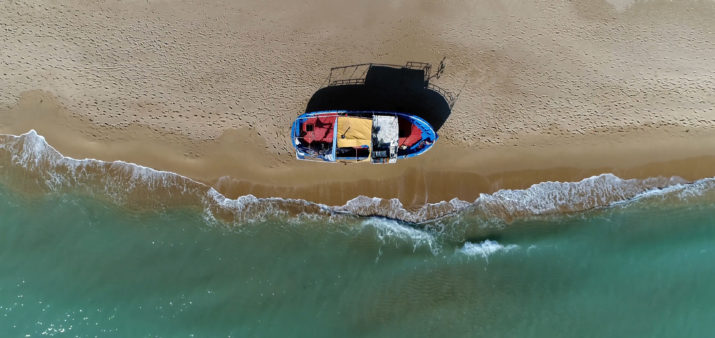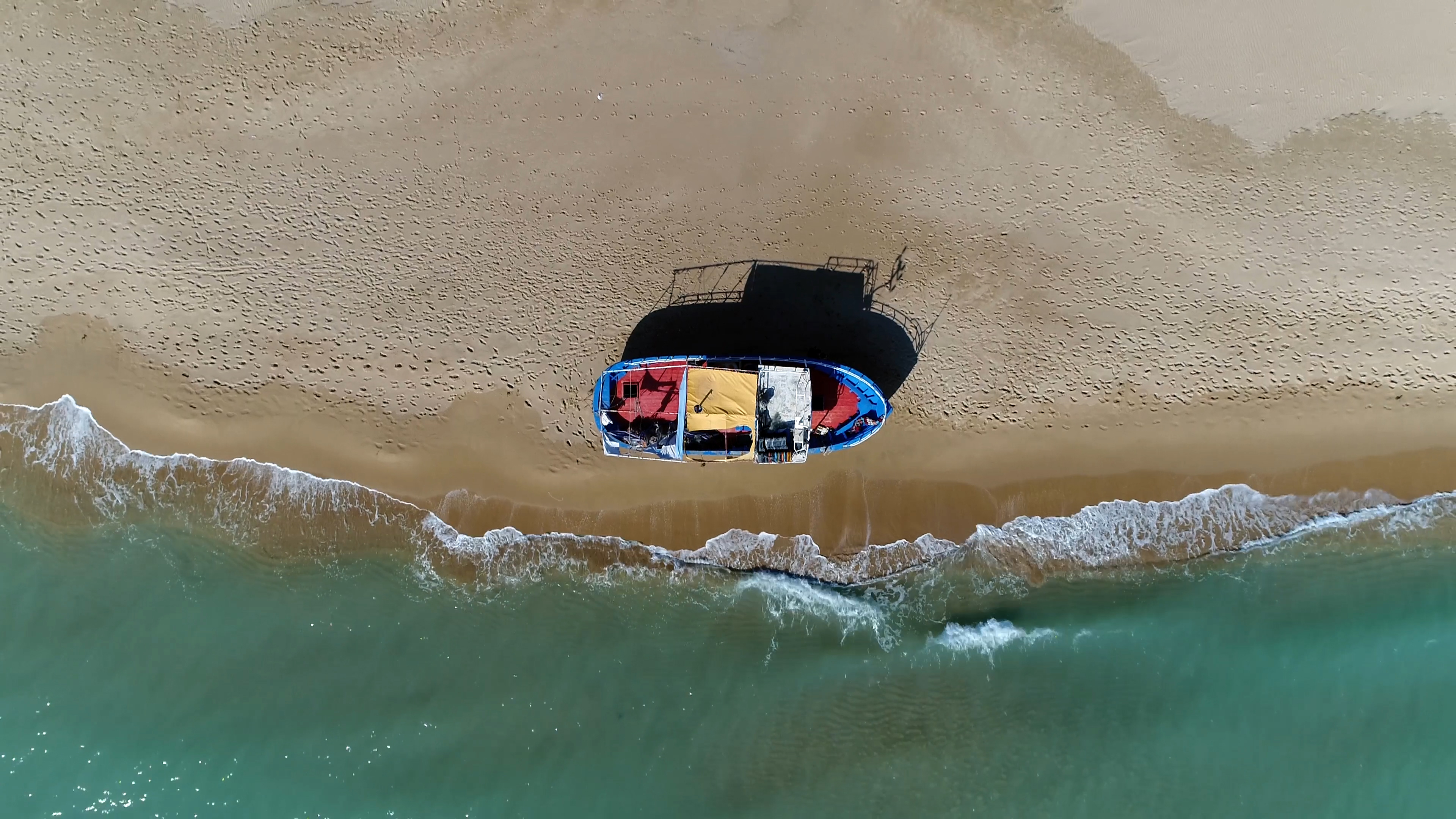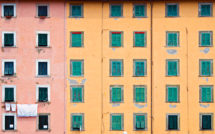

This is part of a round table on the refugee crisis:
-
“Refugees in Athens: There is No Humanity in this Place” by Melissa Kerr Chiovenda
-
“Criminalizing the Mediterranean Leads to Death and Division” by Sharon Jacobs
-
“’I am Odysseus:’ Tracing Mobile Desires and Resistance to Confinement Through Pseudonyms” by Árdís K. Ingvars
In December 2018, twenty-three-year-old Syrian elite swimmer and German asylee Sara Mardini was released on bail after four months in Greek prison. Her crime? Mardini stands accused of people smuggling, espionage, money laundering, and membership in a criminal organization—all because of her role volunteering in Lesvos with the Greek non-governmental Emergency Response Centre International (ERCI).
Mardini last made major news headlines in 2015. Having fled from Syria in search of safety and security in Europe, she and her sister Yusra Mardini were crossing the Mediterranean from Turkey to Greece when the small raft they had boarded with eighteen other passengers started to sink. The two sisters jumped into the sea and started swimming. For more than three hours, they swam alongside their raft, guiding the other passengers to safety. After arriving in Germany and receiving official protection, Yusra Mardini went on to swim in the 2016 Olympics; Sara Mardini took her skills and experience back to Greece, helping travelers like herself as a volunteer spotter and rescuer with ERCI.
Her story took a bizarre turn this past summer, when Mardini was arrested at the airport as she was leaving Lesvos. Along with two other volunteers and the founder of ERCI, Mardini was slapped with serious criminal accusations and sent to a maximum-security prison outside Athens. Mardini and the other three ERCI workers have all been released on bail, but they await the outcome of the criminal case.
Their lawyer, Zacharias Kessos, has decried the charges against them as false and politically motivated. According to Public Radio International, Kessos said in a press conference, “They [the police] believe that as long as we have NGOs and volunteers on the island helping and making better the life of the people, that means that the smuggling teams will continue choosing Lesbos as a point of landing for these people that are trying to go to Europe.” In other words, the Greek police are working against NGOs whose goal is to make migrant journeys to Lesvos less deadly—precisely out of concern that less deadliness might convince more people to attempt the journey.
In a Human Rights Watch report, HRW researcher Bill Van Esveld explicitly linked the charges against Mardini and her fellow aid workers to a broader trend in state actions on migrant travel routes: “Accusations of money laundering, people smuggling, and espionage appear no more than an effort to criminalize humanitarian activism on behalf of refugees and migrants in Greece.” Indeed, the last months of 2018 saw several cases of aid workers and organizations threatened or charged with crimes, preventing them from doing life-saving work on the Mediterranean. In November, Italian public prosecutors accused the “Aquarius,” a rescue ship operated between Libya and Italy by Médecins Sans Frontières, of illegal waste disposal. The prosecutors pointed specifically to the risk of migrant clothing bringing dangerous pathogens to Europe (although at least one of the cited viruses, HIV, cannot be transmitted through clothing). Dogged by this and other pressure points, the Aquarius was finally forced to shutter its operations in December—following weeks of absence of any rescue ship in the Mediterranean in late summer 2018.
The criminalization of rescue work is not limited to Europe. In January 2019, four volunteers with the group No More Deaths/No Más Muertes were convicted of various misdemeanors for the act of leaving food and water for migrants passing through the Arizona desert. In an op-ed published before the verdict, one of the group’s staff members said that the targeting of activist volunteers, racist government rhetoric, military presence at borders, and family separation decrees all come together as “churning wheels in an apparatus of policies intended to make crossing the border a death sentence.”
In his 2015 book Land of Open Graves: Living and Dying on the Migrant Trail, UCLA anthropologist Jason de León documents the violence of the desert border between Mexico and the U.S. A hot and arid climate, wild animals, difficult terrain, and drug dealers and bandits participate in what de León calls the Sonoran Desert “hybrid collectif,” endangering the lives of people attempting irregular border crossings. In this sparsely traveled no-man’s land, even corpses disappear, scattered to the winds and the scavengers; during the course of his research, de León collected photographs and other personal possessions, often all that remained of fallen travelers. These deaths have been made invisible, but they’re not blameless, de León argues. On the contrary, the deaths should be seen as part of a deliberate U.S. Border Patrol strategy to police migration in urban areas, prompting irregular border-crossers to risk their lives in the desert. The goal is to discourage people from attempting to cross the border at all. When volunteer activists leave water in the Sonoran Desert, then, they are actively frustrating Border Patrol by making the crossing more survivable.
The U.S. strategy de León lays out has an official name: Prevention Through Deterrence (PTD). But the general idea—weaponizing nature by forcing migrants to risk death for a chance at life—plays out globally at the edges of the former first world, including on the Mediterranean. Recall German Chancellor Angela Merkel’s 2015 pronouncement that Germany would welcome a million refugees. Her statement carried no promise of safe passage. (Four years later, in March 2019, the European Commission will respond to a European Parliament proposal to issue humanitarian visas that would, in fact, allow individuals to travel in order to open asylum cases.) As things stand, although the right to asylum was enshrined in the UN’s Universal Declaration of Human Rights and ratified by European states in the Geneva Conventions, anyone wishing to open an asylum case in Europe has to get to Europe first. And with Europe short on accessible land borders, many would-be asylum seekers are effectively compelled toward the Mediterranean Sea, as well as the Evros River at Greece’s northern border with Turkey, neither of which routes guarantees safe arrival to European shores.
In 2015, the year of Merkel’s proclamation, 3,771 people died while in transit in the Mediterranean, according to the International Organization for Migration (IOM). Many were traveling in rubber dinghies, often steered by an inexperienced migrant given vague directions by a smuggler before departure from Turkey or North Africa. Weather, water, shoddily constructed vehicles, and lack of technical knowledge form the “hybrid collectif” (in de León’s parlance) against which migrants must contend at sea. While the number of people making irregular borders crossings on the Eastern, Central, and Western Mediterranean routes has indeed decreased since 2015 (a decline usually chalked up to changing political-economic situations in refugee-producing countries, and not successful deterrence), the proportion of deaths to crossings has increased. According to the UNHCR, one in eighteen people trying to cross the Central Mediterranean to Italy died between January and July 2018, up from one in forty-two people last year. Deaths along the Eastern Mediterranean route to Cyprus, Bulgaria, and Greece rose from thirty-eight in 2017 to ninety-nine in 2018. There is a clear correlation: When search-and-rescue goes down, deaths go up.
Blaming the Rescuers—an academic investigation into the criminalization of Mediterranean rescue work—charges European Union member states with the responsibility for migrant deaths as a result of their preventing aid at sea. Led by members of the Forensic Archaeology agency at Goldsmiths, University of London, the Blaming the Rescuers project counters the attacks against humanitarian NGOs that have been launched by Frontex, EU member state governments, and European media organizations. Those actors contend that Mediterranean rescue work motivates migrants to cross, encourages smugglers, and contributes to the risk of sea crossings. The Blaming the Rescuers researchers, in their counterargument, use empirical evidence to demonstrate the falsity of these three claims. They argue that it is European state actors who are making the Mediterranean more dangerous, through verbal delegitimization and legal criminalization of rescue work that prevents such operations from taking place. European state actors “have attempted to deter migrants by making the crossing more difficult, with the only effect of leading to thousands of deaths,” reads the investigation’s summary. A border designed for danger and deadliness by state actors determined to discourage irregular crossings—the picture that Blaming the Rescuers paints evokes the official U.S. strategy of Prevention Through Deterrence in all but its name.
Like their counterparts at the U.S.-Mexico border, Mediterranean rescue ships, NGOs, and individuals like Sara Mardini provide vital services to people traversing weaponized environments. The alternative to rescue work in risky border zones is migrant death, not deterrence, as has been demonstrated in North American and European cases. Humanitarians and solidarians work against migrant death, but they don’t necessarily force migrants back where they came from. Instead, and in accordance with customary international law, ships that rescue travelers in European waters bring them to a safe place where they do not risk persecution—usually the shores of EU countries rather than Libya (where reports have documented enslavement of migrants) or Turkey (which has been found to have illegally forced individuals back to Syria). And when migrants cross into Europe, they enter protected spaces where they can open asylum cases and seek access to the Geneva-guaranteed human rights preventing their deportation. That itself is a threat to empowered immigration-averse segments of the EU. Beginning with the EU-Turkey deal in 2016 and continuing to the present, the EU has increasingly pursued so-called “border externalization strategies,” such as proposed offshore processing centers for asylum claims. Externalization strategies contain potential asylum seekers in spaces outside the EU and extralegal to it, preventing them from physically arriving to sovereign European territory, where they can claim their rights.
Miriam Ticktin, an anthropologist at the New School for Social Research, has noted the similarities between discourses of containment and invasiveness across social contexts, from pathogens to plants to people. Across the board, invasiveness “implies a metaphor of war and attendant processes of militarization, and helps to frame responses accordingly, i.e., one has to fight back” (2017, xxii). Governments and supra-national bodies have launched fights against the movement of viruses and unregulated plants and animals, in addition to humans. (And when it comes to fighting words, humans crossing borders are frequently compared to “swarms” of animals or inanimate “flows” that must be controlled and contained.) This kind of rhetoric was on full display in the run-up to Hungary’s April 2018 parliamentary election. At one rally, far-right Hungarian president Viktor Orbán warned his supporters of an ongoing invasion of Europe by people from the Global South. “Africa wants to kick down our door, and Brussels is not defending us,” he said.
Preventing people from access to Europe is a clear attempt at containment of bodies deemed external and invasive. With the recent calls for offshore processing centers, some European leaders aim to physically contain would-be travelers: Theoretically, asylum seekers would be confined on “regional disembarkation platforms” while the legitimacy of their claims would be assessed. (Granted, the EU has been containing migrants outside its borders for decades through protocols like the Rabat Process and the EU-Africa Partnership on Migration, Mobility and Employment—purportedly in the name of international cooperation and development.) Similarly, through Operation Sophia, the EU aims to prevent sea crossings in the name of anti-smuggling, by working with the same Libyan authorities who have turned a blind eye to migrant slavery. Rather ironically, the operation takes its name from a Somali baby born aboard one of its ships.
Moreover, exaggerated claims of criminal activity on migrant routes serve to delineate and morally contain a sphere of “other”-ness that includes border crossers and rescue workers in the same category as people smugglers, with attendant implications of illegality. The charges Sara Mardini and the other ERCI workers face—people smuggling, espionage, money laundering, and membership in a criminal organization—are fundamentally different from search and rescue work. Smuggling, spying, and financial duplicity can endanger human life; saving the lives of distressed sea travelers does the opposite.
But when humanitarian aid is equated with criminality, the problem is not merely that those providing aid are painted as criminals. Perhaps even more foreboding, the people on the receiving end of aid start to look, not like victims in need of saving—already a problematic framing—but instead like parties to crime. For example, Germany’s Alternative for Deutschland (AfD) party recently claimed that 447 murders had been committed by illegal migrants in 2017. This figure actually included all asylees—most of whom have legal documentation—and criminologists attributed the large number of murders to demographic factors (age and gender) rather than legal status. However, such accusations of immigrant criminality in northern European countries are easier to make when people have been compelled to either commit crimes themselves or engage with people deemed criminal while en route to safe countries. When rescue work is treated as a crime, even having one’s life saved at sea connotes criminal associations.
A war invoked by aggressive rhetoric requires strictly defined sides, and sides require purity. Ticktin notes: “Without purity, it becomes harder to make categorical distinctions between self and other” (xxxii). Here, aid workers and volunteers become border crossers of another kind, mobilizing and frustrating the social boundary between “us” and “them.” This is particularly evident in the case of refugee volunteers like Sara Mardini, a high-profile figure with an inspiring story, who carries both Syrian nationality and German passport privilege. Many of the people offering help and solidarity on the Mediterranean have either crossed weaponized borders themselves or waited anxiously for a Whatsapp message or a phone call from a loved one making such a journey. By equating solidarity with smuggling and other crimes, the Greek state and other European governments reject nuances of identity and interpersonal connections. Instead, they set up volunteers and NGO workers as invasive “others” themselves, expelled morally from the national self and subject physically to containment in the form of lengthy prison sentences.
One large-scale producer of asylum seekers in Europe, the Islamic State of Iraq and Syria (ISIS), has coined the term “grayzone” to describe what it sees as an untenable gap between a Muslim “us” and Western “them.” “Muslims in the West will soon find themselves between one of two choices,” the group said in its online magazine Dabiq in 2015—either the West or Islam, but not both. Academic and journalistic analyses of ISIS have documented the ways the organization targets so-called “moderate” Muslim citizens and European Islamic communities in order to collapse the grayzone and force individuals to pick a side. The irony of EU state efforts to criminalize humanitarian and solidarity work in the Mediterranean is that such delegitimization leads to a similar result of shrinking the grayzone. Preventing people from helping each other and building solidarity networks heightens the social and physical distance between EU citizens and non-citizen migrants. It forces people to the sides. In Europe and around the world, rescue and solidarity work breaks down the barriers between black-and-white sides. Rather than polarization, it produces a shared grayzone of humanity. Efforts at criminalizing rescue work suggest that, even in the secular and liberal EU, shared human grayzones run counter to prevalent governance strategies.
Sharon Jacobs is a Ph.D. candidate in anthropology at the University of Pennsylvania. Her research will investigate the material and affective dimensions of instability among asylum seekers in Athens, Greece.
References:
Barbuscia, Davide. “Italy accuses NGO migrant ship of dumping toxic waste,” Reuters, November 20, 2018. https://www.reuters.com/article/us-europe-migrants-italy-aquarius/italy-accuses-ngo-migrant-ship-of-dumping-toxic-waste-idUSKCN1NP1E4.
Blaming the Rescuers. Accessed December 21, 2018. https://blamingtherescuers.org/.
Campana, Fahrinisa. “Syrian refugee ‘hero swimmer’ Sara Mardini is out of prison. She plans to keep helping refugees,” Public Radio International, December 14, 2018. https://www.pri.org/stories/2018-12-14/syrian-refugee-hero-swimmer-sara-mardini-out-prison-she-plans-keep-helping.
De León, Jason. The Land of Open Graves: Living and Dying on the Migrant Trail. Berkeley: University of California Press, 2015.
“Desperate Journeys: Refugees and migrants arriving in Europe and at Europe’s borders.” UNHCR report, accessed December 21, 2018. https://www.unhcr.org/desperatejourneys/.
“Greece: Rescuers at Sea Face Baseless Accusations.” Human Rights Watch, November 5, 2018. https://www.hrw.org/news/2018/11/05/greece-rescuers-sea-face-baseless-accusations.
“Humanitarian visas would reduce refugees’ death toll.” European Parliament press release, December 3, 2018. http://www.europarl.europa.eu/news/en/press-room/20181203IPR20713/humanitarian-visas-would-reduce-refugees-death-toll.
Hussain, Murtaza. “Islamic State’s Goal: ‘Eliminating the Grayzone’ of Coexistence between Muslims and the West.” The Intercept, November 17, 2015. https://theintercept.com/2015/11/17/islamic-states-goal-eliminating-the-grayzone-of-coexistence-between-muslims-and-the-west/.
International Metropolis Conference. “The Mexican wall and pushing back boats – do
deterrence policies work?” October 8, 2018. https://metropolis2018.org.au/cms/wp-content/uploads/2018/04/Media-Release_Metropolis2018_The-Mexican-wall-and-pushing-back-boats-%E2%80%93-do-deterrence-policies-work.pdf.
“IOM Counts 3,771 Migrant Fatalities in Mediterranean in 2015.” International Organization for Migration press release, January 5, 2016. https://www.iom.int/news/iom-counts-3771-migrant-fatalities-mediterranean-2015.
Nebehay, Stephanie. “Executions, torture and slave markets persist in Libya: U.N.” Reuters, Marh 21, 2018. https://www.reuters.com/article/us-libya-security-rights/executions-torture-and-slave-markets-persist-in-libya-u-n-idUSKBN1GX1JY.
Orlovsky-Schnitzler, Justine. “The Desert Should Not Be a Death Sentence,” New York Times, December 18, 2018. https://www.nytimes.com/2018/12/18/opinion/migrants-border-death.html.
Prendergast, Curt. “Tucson federal judge convicts 4 border-aid volunteers.” Arizona Daily Star, January 18, 2019. https://tucson.com/news/local/tucson-federal-judge-convicts-border-aid-volunteers/article_237e51ce-1b6f-11e9-9c3c-ab5ab1b4e19a.html.
Reality Check Team. “Reality Check: Are migrants driving crime in Germany?” BBC, September 13, 2018. https://www.bbc.com/news/world-europe-45419466.
Ticktin, Miriam. “Invasive Others: Toward a Contaminated World.” Social Research: An International Quarterly 84, no. 1 (Spring 2017): xxi-xxxiv.
Tondo, Lorenzo and Karen McVeigh. “No NGO rescue boats currently in central Mediterranean, agencies warn,” The Guardian, September 12, 2018. https://www.theguardian.com/world/2018/sep/12/migrant-rescue-ships-mediterranean.
“Turkey: Mass Deportations of Syrians.” Human Rights Watch, March 22, 2018. https://www.hrw.org/news/2018/03/22/turkey-mass-deportations-syrians.
Walker, Shaun. “Hungarian leader says Europe is now ‘under invasion’ by migrants,” The Guardian, March 15, 2018. https://www.theguardian.com/world/2018/mar/15/hungarian-leader-says-europe-is-now-under-invasion-by-migrants.
Published on February 5, 2019
Photo: Aerial photo of azure blue ocean stranded refugee boat at southern mediterranean beach | Shutterstock
Published on February 5, 2019




